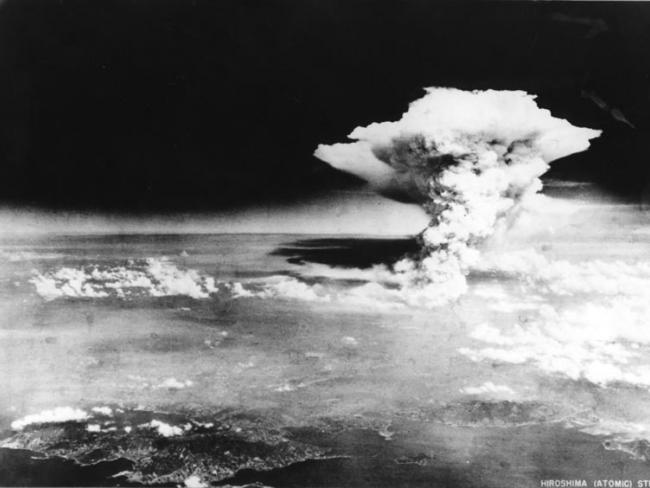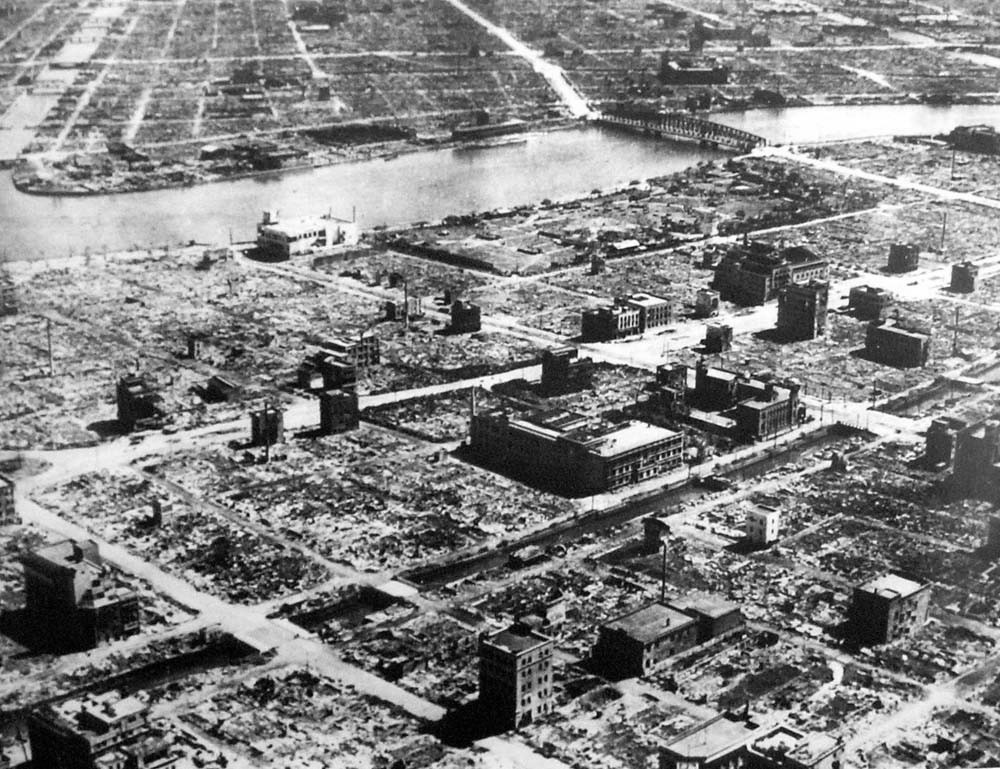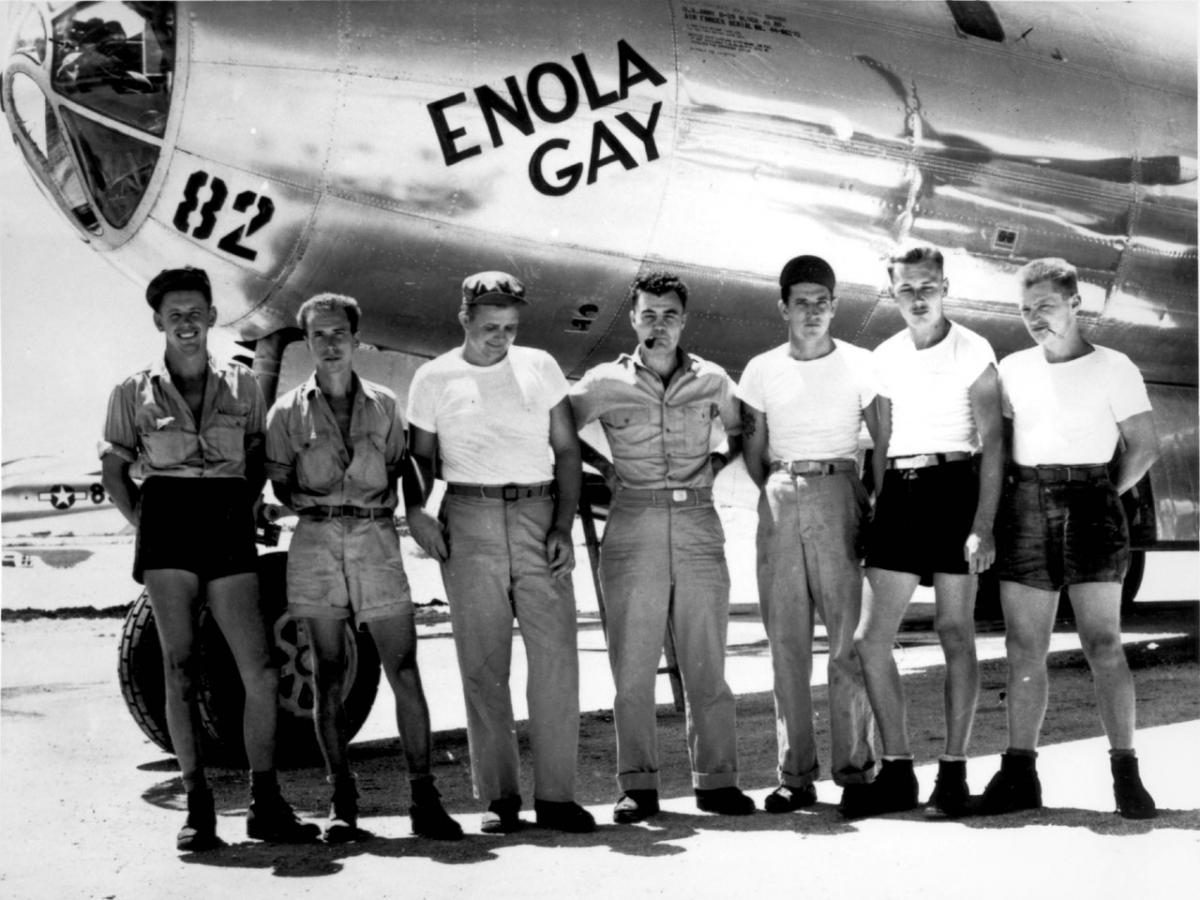28 July 2015

The now-familiar mushroom cloud rises about the ruined city of Hiroshima.
Seventy years ago this August, America exploded atomic bombs over two Japanese cities. Controversy still rages as to why they were used and whether these weapons should have been authorised. The USA remains the only state to have deployed nuclear weapons in warfare.
Seven decades after the dropping of atomic bombs on two Japanese cities, American governments are still justifying the bombings by claiming they helped bring the war with Japan to a speedy conclusion. The claim is that by avoiding a costly invasion of Japan the bombing spared countless lives of Allied soldiers and even Japanese civilians.
Not everyone has agreed with this interpretation. Many historians, including some Americans, argue that dropping the atomic bombs was unnecessary. They say an allied invasion planned for October 1945 could have gone ahead.
Others go further and stress that the reason behind the atomic attack was political. Their view is that the USA’s purpose was to demonstrate the awesome power of their new exclusive weapon of mass destruction and to intimidate the Soviet Union. The USSR had a nuclear programme, but it did not then possess the technology to explode atomic bombs.
Cold war
Unleashing the atom bombs was arguably the opening shot of the Cold War, the drastic change of tack by western imperialism that sought to turn the Soviet Union from crucial wartime ally into number one enemy.

The war in Europe ended on 8 May 1945 with the unconditional surrender of Nazi Germany. But the Pacific War continued, as the Japanese refused to accept the Allies’ demand for unconditional surrender. In the face of that stance, the Allies began preparations for an invasion of the Japanese mainland, Operation Downfall.
The USA also carried out an immensely destructive firebombing campaign from February 1945 onwards. More than 100 Japanese towns and cities were hit. Many were obliterated, including Tokyo on 9 March. That was the deadliest air raid of World War Two, killing an estimated 100,000 people in one night. Three-quarters of the bombs were incendiaries designed to burn down Japan’s “paper cities”.
This shows that America’s dedication to aerial “shock and awe” dates back long before the Gulf Wars. The initiator of the firebombing campaign against Japan was General Curtis LeMay, the same man who later threatened to bomb Vietnam back into the Stone Age.
‘The initiator of the firebombing campaign was Curtis LeMay, the same man who later threatened to bomb Vietnam back into the Stone Age.’
Official statements started to appear claiming an invasion of Japan would cause horrendous casualties, weakening the case for that option. For example, the US Joint War Plans Committee estimated an invasion would result in between 130,000 and 220,000 US casualties and 25,000 to 46,000 deaths. Other reports estimated up to 4 million casualties and 800,000 deaths. All said Japanese fatalities would have been far higher, around 5 to 10 million.
Speculation about events that hadn’t happened is nonsensical. Casualties might have been high or low, but no one can ever know because the invasion scenario did not occur.
Manhattan Project
In October 1941, fearing that Nazi Germany was close to producing viable weapons, the US decided to produce an atomic bomb. Its declaration of war on Japan and Germany that December accelerated the development.
At the start of 1942 the United States launched the Manhattan Project to research the potential for atomic weapons. Germany was doing the same. Other countries – including Japan – carried out some research, but to a much lesser extent. The Manhattan Project aims included tracking German activity and attempting to sabotage it.
By mid 1942 construction had started on the immense industrial facilities needed to produce the fissile material from which the bombs were made.
British scientists had provided crucial scientific information about the viability of atomic weapons. As Britain did not have the resources to develop an atomic bomb independently, the British project, codenamed “Tube Alloys” was incorporated into Manhattan in 1943. Canada also participated as a source of uranium ore and produced heavy water, an essential ingredient for the process of making the bombs.
Eventually, two types of bomb were devised. In line with American imperialism’s fondness for naming deadly armaments with innocuous titles, these were called “Little Boy” and “Fat Man”.
Fat Man used plutonium. It was more powerful and efficient than Little Boy, which used uranium, but its mechanism was more complicated. On 16 July 1945, America conducted its first successful test of an atomic bomb in the New Mexico desert.
Potsdam summit
From 17 July until 2 August, the final summit of the leaders of the wartime allies took place at Potsdam. Winston Churchill represented Britain, Joseph Stalin the USSR and Harry Truman the USA. Churchill was later replaced by Clement Attlee when he became British Prime Minister on 26 July following the Labour Party’s general election victory. Since the previous summit at Yalta, President Roosevelt had died to be replaced by Truman who, unlike Roosevelt, was virulently anti-Soviet. Potsdam witnessed a change in relations and was full of tension and recriminations.
On 26 July, the USA and Britain issued the Potsdam Declaration outlining terms of surrender for Japan. Presented as an ultimatum it stated that without surrender, the Allies would attack Japan, resulting in “the inevitable and complete destruction of the Japanese armed forces and just as inevitably the utter devastation of the Japanese homeland”. The atomic bomb was not mentioned in the communiqué.
‘Truman informed Stalin at Potsdam that he had a new weapon of great destructive force, without telling him what it was.’
Truman, who delayed the start of Potsdam to ensure the atomic test had gone ahead in New Mexico, informed Stalin at Potsdam that he had a new weapon of great destructive force, without telling him what it was. Truman did not want the Soviet Union and Stalin involved in the terms of Japan's surrender. He thought that the US atomic monopoly might offer diplomatic leverage against the Soviet Union.
On 28 July, the Japanese government rejected the terms for surrender. Emperor Hirohito was waiting for a Soviet reply to Japanese peace feelers. He made no move to change the government position, even though there were internal debates about surrender.

On 6 August, 1945, President Truman authorised an American bomber, Enola Gay, to drop the Little Boy atomic bomb over the Japanese city of Hiroshima. It exploded 2,000 feet above the city, producing a blast equivalent to the power of 15,000 tons of TNT. This immediately killed 80,000 people, around 30 percent of the city’s population. Five square miles of the city were destroyed by blast or fire.
Tens of thousands more people died in the following weeks from wounds and radiation poisoning. Little Boy exploded over Hiroshima, destroying five square miles of the city. Over 90 per cent of the doctors and nurses in Hiroshima had been killed or injured.
After the Hiroshima bombing, President Truman issued a statement announcing the use of the new weapon. He stated, “We may be grateful to Providence” that the German atomic bomb project had failed, and that the United States and its allies had “spent two billion dollars on the greatest scientific gamble in history—and won.”
The Yalta agreement in February 1945 had required the Soviet Union to join the war against Japan within three months of the end of war in Europe. That was due by the end of 9 August, as the Soviet Union classified VE Day as 9 May. On 5 August, the Soviet Foreign Minister Molotov informed Japan of the Soviet Union's unilateral abrogation of the Soviet–Japanese Neutrality Pact.
Soviet attack
On 9 August Soviet armed forces launched a strategic offensive with 1.6 million troops against the Japanese Kwantung Army in Manchuria. Over the preceding weeks and months, the Soviet Union had transferred over a million soldiers across Siberia to join the offensive, a formidable task. “The Soviet entry into the war,” argues Japanese historian Tsuyoshi Hasegawa, “played a much greater role than the atomic bombs in inducing Japan to surrender because it dashed any hope that Japan could terminate the war through Moscow's mediation.”
Since there was no indication of Japan surrendering, the American government decided to drop another bomb. On 9 August, the US plane Bockscar dropped the Fat Man bomb over the industrial valley at Nagasaki. Although the bomb was about 30 per cent more powerful than the one used on Hiroshima, the blast was confined to the narrow Urakami Valley and a major portion of the city was protected by intervening hills. Even so the radius of total destruction was about 1 mile, followed by fires across the northern portion of the city.
An estimated 263,000 people were in Nagasaki at the time. Estimates of immediate deaths vary widely, ranging from 22,000 to 75,000. During the following months, large numbers died from the effect of burns, radiation sickness and other injuries, compounded by illness and malnutrition.
‘The bombs were dropped “without any military need whatsoever” – Marshal Zhukov’
Many believe the second bomb, a different design to the first, was dropped primarily to allow the US military and scientists to see how they worked and how effective they both were. In both cities, most of the dead were civilians, although Hiroshima had a sizable military garrison. Marshal Zhukov of the Soviet Union said the bombs were dropped “without any military need whatsoever” – a strong statement from the victor of Stalingrad and the most successful general of the war.
The same day – 9 August – Emperor Hirohito ordered the Japanese government to “quickly control the situation...because the Soviet Union has declared war against us.” He then held an Imperial conference to discuss surrender, during which he authorised a minister to notify the Allies that Japan would accept their terms on condition the declaration “does not comprise any demand which prejudices the prerogatives of His Majesty as a Sovereign ruler.”
The timing here is important. News of the Soviet attack reached Tokyo at 4.00 am on 9 August. Hirohito’s surrender conference – no other imperial meeting had discussed surrender – was already under way by the time the Nagasaki bomb was dropped (11.02 am local time).
Capitulation
On 14 August, Hirohito recorded his capitulation announcement, broadcast to the Japanese nation the next day, just days after the bombing of Nagasaki and the Soviet Union's declaration of war. In the Emperor’s message to the Japanese armed forces delivered on 17 August, he stressed the impact of the Soviet invasion and his decision to surrender, omitting any mention of the bombs. However, Hirohito met with US General MacArthur on 27 September, saying to him that “the peace party did not prevail until the bombing of Hiroshima created a situation which could be dramatised.”
Opposition to the atomic bombings has taken a variety of standpoints. One strand says they are fundamentally immoral as war crimes or state terrorism. Another view is that they were militarily unnecessary because of the fierce conventional firebombing campaign and the collapse of Germany making possible redeployment of military forces to the Pacific War. The implementation of a sea blockade of Japan could have led to a Japanese surrender.
Excluding the Soviet Union
Militarily Japan was finished, as the Soviet rout of Japanese forces in Manchuria proved. As important – perhaps – as wanting to demonstrate atomic power to the Soviet Union was the political imperative of excluding the Soviet Union from the peace agreement with Japan and limiting its troops’ movements in Manchuria, China, Korea and Japan. Truman and America did not want the USSR to have a claim to participate in the occupation of Japan. Many feel the United States used nuclear weapons in order to nullify the Soviet Union.
Following Potsdam and Hiroshima, Stalin and the government of the Soviet Union read the clear signs that the atom bomb was directed as much at the Soviet Union as at Japan. According to Marshal Zhukov’s memoirs, on the same night as President Truman mentioned a new weapon, Stalin sent a telegram to Moscow which led to immediate steps being taken to accelerate the Soviet atomic bomb project through a rapid development of military nuclear reactors and a massive expansion of research facilities.
Matters progressed rapidly. The Soviet Union tested an atomic bomb in August 1949. America’s nuclear monopoly was broken.
